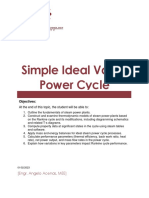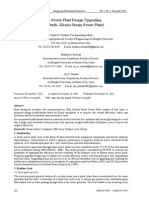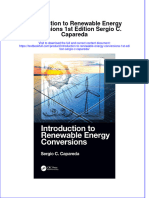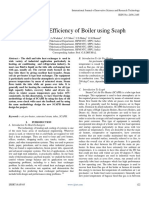Thermodynamic Analysis of Rankine Cycle in Ocean Thermal Energy Conversion
Thermodynamic Analysis of Rankine Cycle in Ocean Thermal Energy Conversion
Uploaded by
Kumar KumarCopyright:
Available Formats
Thermodynamic Analysis of Rankine Cycle in Ocean Thermal Energy Conversion
Thermodynamic Analysis of Rankine Cycle in Ocean Thermal Energy Conversion
Uploaded by
Kumar KumarOriginal Description:
Original Title
Copyright
Available Formats
Share this document
Did you find this document useful?
Is this content inappropriate?
Copyright:
Available Formats
Thermodynamic Analysis of Rankine Cycle in Ocean Thermal Energy Conversion
Thermodynamic Analysis of Rankine Cycle in Ocean Thermal Energy Conversion
Uploaded by
Kumar KumarCopyright:
Available Formats
FENGYUN CHEN et al: THERMODYNAMIC ANALYSIS OF RANKINE CYCLE IN OCEAN THERMAL . . .
Thermodynamic Analysis of Rankine Cycle in Ocean Thermal Energy Conversion
Fengyun Chen1,2*, Liang Zhang1, Weimin Liu2, Lei Liu2, Jingping Peng2
1 Harbin Engineering University
Harbin, Heilongjiang 150001, China
2 First Institute of Oceanography State Oceanic Administration
Qingdao 266061, Shandong, China
*For correspondence: cfyqdu2000@163.com
Abstract — The thermodynamic cycle efficiency is low because the temperature difference is very small in the ocean thermal energy
conversion (OTEC) system, so it is particularly important to increase the cycle efficiency when the OTEC is developed and utilized.
In this paper the cycle efficiency calculation method of the ocean thermal energy conversion (OTEC) is obtained through the
theoretical analysis and model establishment of the equipment in the OTEC system according to the first and second law of
thermodynamics for Rankine cycle, and also the influence of turbine inlet pressure, warm and cold seawater temperature on the
thermal and exergy efficiency are obtained. At last the development and utilization direction of OTEC system is proposed. This
research will guide the thermodynamic cycle selection and operating parameters optimization of the low grade energy utilization.
Keywords - ocean thermal energy conversion, Rankine cycle, thermodynamic efficiency, exergy efficiency, terminal temperature
difference
heat power generations prefer to use organic Rankine cycle
I. INTRODUCTION with low boiling point organic working medium [2]. Pure
Ocean thermal energy is large reserves, renewable, no ammonia is mostly used as working medium in OTEC [3].
fluctuation with day and night and no pollution. Besides used In the OTEC the principle of Rankine cycle is showed in
to generate electricity the ocean thermal energy can also be Fig.1. First the working fluid is pumped into the evaporator
air conditioning refrigeration, deep seawater products, where it is vaporized and then drives a turbine. The turbine
marine chemical, desalination and other accessory exhaust is condensed by the cold seawater and then into the
development. So the ocean thermal energy is generally pump. In this paper, thermal properties of working medium
considered to be the most potential of development and of the equipment before and after are calculated, and
utilization value by the international society. Development of operation parameters of cycle are determined. Also the
ocean thermal energy can not only can reduce the pressure thermodynamic efficient is analyzed.
on our energy, adjust the energy structure, but also to be
beneficial to environmental protection of our country [1].
Although ocean thermal energy is high energy density in
the ocean energy, the temperature difference is very small, so
the thermodynamic cycle efficiency of OTEC is relatively
low. When the warm seawater temperature is 25 ℃ and cold
seawater is 5℃, ideal Carnot cycle efficiency is only about
6.7%. So it is extremely important to study the
thermodynamic calculation of the OTEC cycle. In this paper,
it is calculated for Rankine cycle according to the laws of
thermodynamics.
II. MATERIALS AND METHODS
A. Principle of Rankine cycle
Figure 1: Principle of Rankine cycle
Rankine cycle is a thermodynamic cycle of steam power
machine. Adopted by the modern large-scale thermal power B. Thermal progress of cycle
plant is developed on the basis of the Rankine cycle, and also
Rankine cycle is the basic cycle of the waste heat recovery, The T-S diagram of Rankine cycle is showed in Fig.2. In
geothermal and solar power device. The earliest Rankine the T-S diagram 1-2 is the progress of turbine doing work, 2-
cycle uses water as working medium, and now most of waste 3 is condensed in the condenser of working medium, 3-4 is
DOI 10.5013/IJSSST.a.17.13.07 7.1 ISSN: 1473-804x online, 1473-8031 print
FENGYUN CHEN et al: THERMODYNAMIC ANALYSIS OF RANKINE CYCLE IN OCEAN THERMAL . . .
the process of working medium through the pump, 4-1 is the (2) Ignore the pressure loss of the heat exchanger and
evaporation of working medium in the evaporator. pipe.
III. RESULTS
E. The influence of the warm temperature change on the
system
When the inlet temperature of warm seawater is 27℃, 28
℃, 29℃, 30 ℃, 31℃, and cold seawater temperature is 4℃,
and also the mass-flow rate of work fluid is constant, obtain
a series of data of the Rankine cycle by the program.
F. Relationship between net output work and terminal
temperature difference of heat exchanger
Thermodynamic cycle efficiency and net output work of
the generator should be considered when comparing the
advantages and disadvantages of different working
conditions. With the increasing of generator output mass-
flow of warm seawater and work fluid increases, and the
Figure 2: The T-S diagram of Rankine cycle consumed work of warm/cold seawater pump and work fluid
pump also increase accordingly. So the net output work of
C. Thermodynamic model of equipment the system should be considered.
(1) Evaporator The effect of terminal temperature difference on net
The thermal equilibrium equation of evaporator output of system is showed as Fig3. It can be seen when
mass-flow of working fluid is constant, with the increase of
QE m (h1 h4 ) (1)
terminal temperature difference of evaporator, in other
QE — heat transfer of the evaporator, kW; m —mass- words, the temperature difference between outlet of working
fluid and inlet of warm seawater in evaporator is larger, and
flow rate of work fluid, kg/s; hn —enthalpy of n, kJ/kg. the net output work is smaller. Because the terminal
(2) The thermal equilibrium equation of condenser temperature difference increases, and the steam temperature
QC m(h2 h3 ) (2) of turbine inlet decrease, work capacity is reduced
accordingly, net output work of the system decreases. If
QC —heat transfer of the condenser, kW; terminal temperature difference is under the same conditions,
(3) Power generation of turbine the inlet temperature of warm seawater is higher; and the net
Wt m(h1 h2 ) output work is larger. Because with the increasing of warm
(3) seawater temperature, the available temperature difference of
Wt —power generation of turbine, kW; system increases, also the steam temperature of turbine inlet
and work capacity increase, the net output work of system
(4) Work fluid pump
increases.
WP m(h4 h3 ) (4)
(5) Thermodynamic cycle efficiency 38
( h h ) (h5 h4 )
t 1 2 (5)
h1 h4 W
36
)
k
(6) Net work of output 34
︵
net output work
W Wt Wp (6)
32
Warm seawater(27℃)
D. The calculation condition Warm seawater(28℃)
30
The research shows temperature difference between the Warm seawater(29℃)
import and export of the heat exchanger is about 2~ 4℃. In Warm seawater(30℃)
28
Warm seawater(31℃)
order to make the ammonia boil in the evaporator and
1.0 1.5 2.0 2.5 3.0 3.5
condense in the condenser, in this paper 2℃ is selected of terminal temperature difference(℃)
the terminal temperature in the heat exchanger. At the same
time in the process of calculation thermodynamic cycle is
simplified as follows: Figure 3: Effect of terminal temperature difference on net output work of
(1) Gas expending in the turbine is simplified as the system
isentropic expansion
DOI 10.5013/IJSSST.a.17.13.07 7.2 ISSN: 1473-804x online, 1473-8031 print
FENGYUN CHEN et al: THERMODYNAMIC ANALYSIS OF RANKINE CYCLE IN OCEAN THERMAL . . .
The relationship between cycle efficiency and terminal
temperature difference is showed as Fig.4. It is found that 15.48
when mass-flow of working fluid is constant and the inlet 15.46
temperature of the warm seawater is determined, cycle 15.44
efficiency decreases and the heat of the work fluid absorbed
exergy efficiency(%)
15.42
from evaporator reduce with the terminal temperature 15.40
difference increasing. 15.38
15.36
3.6 warm seawater(27℃)
15.34 warm seawater(28℃)
3.5 15.32 warm seawater(29℃)
thermodynamic efficiency(%)
15.30 warm seawater(30℃)
3.4
warm seawater(31℃)
15.28
3.3 1.0 1.5 2.0 2.5 3.0 3.5
3.2 terminal temperature difference(℃)
3.1 Warm seawater(27℃)
Warm seawater(28℃) Figure 5: Relationship between exergy efficiency and terminal temperature
3.0
Warm seawater(29℃) difference
2.9 Warm seawater(30℃)
Warm seawater(31℃)
2.8 G. The influence of cold water temperature on the system
1.0 1.5 2.0 2.5 3.0 3.5 The relationship between cold seawater temperature and
terminal temperature difference( ℃) net output work is shown in figure 6.The output work
decreases with the increase of cold seawater temperature.
Because if the inlet temperature of cold seawater increases,
Figure 4: relationship between thermodynamic efficiency and terminal the backpressure of turbine increases, and also the enthalpy
temperature difference
drop of working fluid in the turbine decreases. So the output
When the terminal temperature difference is constant, the work of turbine decreases.
cycle efficiency increases with the inlet temperature of warm
seawater increasing. When the temperature of warm 42
seawater rises from 27℃ to 31℃, cycle efficiency increases
40
output work of turbine(kW)
from 3.228% to 3.250%. Because with the increasing of
warm seawater temperature, the available temperature 38
difference of system increases, according to the formula of 36
efficiency the cycle efficiency increases. 34
Figure 5 shows the exergy efficiency of system changes
with terminal temperature difference. It can be seen when 32
mass-flow of working fluid is constant, the exergy efficiency 30
decreases with the terminal temperature difference 28
increasing. Because with the terminal temperature difference
increasing, the absorption curve of the working fluid in the 26
4 5 6 7 8
evaporator matches with the exothermic curve of the warm
cold seawater temperature( ℃)
seawater worse, and the irreversible heat transfer losses
increase. Under the same terminal temperature difference,
the warm inlet temperature is higher; the system cycle Figure 6: Relationship between cold seawater temperature and net output
exergy efficiency is lower. When the warm rise from 27℃ to work of the system
31 ℃ , cycle exergy efficiency decreases from 15.42% to From the figure 7 it can be seen when the warm seawater
15.38%. temperature is 29℃, and the other parameters are constant,
the thermodynamic efficiency decreases and the exergy
efficiency increases with the increasing of the cold seawater
temperature. When the warm temperature rises from 4℃ to 8
℃ , thermodynamic efficiency decreases from 3.238% to
1.927% and the exergy efficiency increases from 15.41% to
15.89%.
DOI 10.5013/IJSSST.a.17.13.07 7.3 ISSN: 1473-804x online, 1473-8031 print
FENGYUN CHEN et al: THERMODYNAMIC ANALYSIS OF RANKINE CYCLE IN OCEAN THERMAL . . .
Because ocean temperature difference energy is
3.4 15.9 abundant, it doesn’t consider exergy efficiency when the
3.2
thermodynamic efficiency system operation parameters is determined, just need the
exergy efficiency 15.8
largest net power output of the system
thermodynamic efficiency(%)
3.0
exergy efficiency(%)
15.7
2.8 V. CONCLUSIONS
2.6 15.6 The effect of warm and cold seawater temperature on the
OTEC system is very great. When the warm seawater
2.4 15.5 temperature increases, thermal efficiency, turbine output
2.2 power and net power output of system will be increased.
15.4
Cold seawater temperature lower can improve cycle
2.0
4 5 6 7 8 efficiency, turbine output power. So it is important to choose
cold seawater temperature( ℃) the location where surface temperature is higher and it
doesn’t need too long cold water pipe to obtained cold
seawaters.
Figure 7: Relationship between thermodynamic and exergy efficiency and
cold seawater
REFERENCES
IV. DISCUSSION [1] Wang Zhong, Wang Chuankun, “Analysis on renewable ocean energy
The OTEC system are analyzed according to the first and use in China,” Marine Environmental Science, vol. 11, no. 04, pp. 78-
80, 2006.
second law of thermodynamics, it is concluded that Rankine
[2] Hung TC. “Waste heat recovery of organic Rankine cycle using dry
cycle thermodynamic and exergy efficiency increases with fluids.” Energy Conversion and Management, vol. 42, no. 05, pp.
the turbine outlet pressure, but due to the limitation of the 539-553, 2001.
highest pressure, the thermodynamic and exergy efficiency [3] Jadhav MSM, Kale MRG. “Ocean thermal energy conversion.”
will be lower when the pressure reaches a certain value. Alternative Energy Sources, vol. 90, no. 12, pp. 69-75, 2005.
DOI 10.5013/IJSSST.a.17.13.07 7.4 ISSN: 1473-804x online, 1473-8031 print
You might also like
- Chapter 3 AdditionalDocument7 pagesChapter 3 AdditionalYoseph Mersha100% (3)
- Loyola Marymount RankineCyclerDocument22 pagesLoyola Marymount RankineCyclerKevin LangleyNo ratings yet
- General Physics 1 - Budget of WorkDocument11 pagesGeneral Physics 1 - Budget of Workanon_145781083No ratings yet
- Explore The Influence of Intermediate Extraction On Thermodynamic Performance and Economy of Uehara CycleDocument6 pagesExplore The Influence of Intermediate Extraction On Thermodynamic Performance and Economy of Uehara CycleamfNo ratings yet
- Gethermie ORCDocument7 pagesGethermie ORCSyaiful FuadNo ratings yet
- The Performance of An Irreversible Carnot Refrigeration CycleDocument6 pagesThe Performance of An Irreversible Carnot Refrigeration CycleYalçın DurmuşoğluNo ratings yet
- Accepted Manuscript: Applied Thermal EngineeringDocument24 pagesAccepted Manuscript: Applied Thermal EngineeringAnkit Lonare100% (1)
- Chemical Thermodynamics Assignment (Ecodu)Document18 pagesChemical Thermodynamics Assignment (Ecodu)johnpatrickecoduNo ratings yet
- Applied Thermal Engineering: Jung-In Yoon, Chang-Hyo Son, Seung-Moon Baek, Byung Hyo Ye, Hyeon-Ju Kim, Ho-Saeng LeeDocument5 pagesApplied Thermal Engineering: Jung-In Yoon, Chang-Hyo Son, Seung-Moon Baek, Byung Hyo Ye, Hyeon-Ju Kim, Ho-Saeng LeeJoseph Liev Barraza DiazNo ratings yet
- IntroductionDocument4 pagesIntroductionHazel AdoNo ratings yet
- Chap 1 - Steam Power PlantDocument60 pagesChap 1 - Steam Power PlantMuhammad Qusyairi100% (2)
- Power Plant Chapter 2Document48 pagesPower Plant Chapter 2muhaba muhamedNo ratings yet
- Kalina Exergy Analysis of A Dual Level Binary Geothermal Power Plant 2002 GeothermicsDocument16 pagesKalina Exergy Analysis of A Dual Level Binary Geothermal Power Plant 2002 GeothermicsHassanKMNo ratings yet
- Evaluation of A Novel OTEC System Composed of Uehara Cycle For Power and Refrigeration CogenerationDocument6 pagesEvaluation of A Novel OTEC System Composed of Uehara Cycle For Power and Refrigeration CogenerationamfNo ratings yet
- Design of Steam Generators Numerical Calculation Program ForDocument18 pagesDesign of Steam Generators Numerical Calculation Program ForTriambakeshwarNo ratings yet
- Energy: H. Rosyid, R. Koestoer, N. Putra, Nasruddin, A.A. Mohamad, YanuarDocument9 pagesEnergy: H. Rosyid, R. Koestoer, N. Putra, Nasruddin, A.A. Mohamad, YanuarIvanNo ratings yet
- Operation of Reheat Steam Temperature Control Concept in Sub Critical Boiler: Operational Review Practices and MethodologyDocument6 pagesOperation of Reheat Steam Temperature Control Concept in Sub Critical Boiler: Operational Review Practices and MethodologyNuraini Abdul AzizNo ratings yet
- Pinch and Approach Point On HRSGDocument12 pagesPinch and Approach Point On HRSGluaguNo ratings yet
- Exergetic Sensitivity Analysis of ORC Geothermal Power Plant Considering Ambient TemperatureDocument8 pagesExergetic Sensitivity Analysis of ORC Geothermal Power Plant Considering Ambient TemperatureMatheus M. DwinantoNo ratings yet
- Combined ORC+VAMDocument10 pagesCombined ORC+VAMKailas NimbalkarNo ratings yet
- Lab Heat PumpDocument9 pagesLab Heat PumpShahran IezzatNo ratings yet
- G Ravi - Analysis of Transformer Temperature Rise and Loss of Life in The Presence of Harmonic Load CurrentsDocument6 pagesG Ravi - Analysis of Transformer Temperature Rise and Loss of Life in The Presence of Harmonic Load CurrentskarnatisharathNo ratings yet
- s0360 5442 (00) 00063 3Document13 pagess0360 5442 (00) 00063 3Alvaro AntonioNo ratings yet
- Energy Conversion and Management: Javier Peña-Lamas, Juan Martinez-Gomez, Mariano Martín, José María Ponce-OrtegaDocument11 pagesEnergy Conversion and Management: Javier Peña-Lamas, Juan Martinez-Gomez, Mariano Martín, José María Ponce-OrtegaJuan MartinezNo ratings yet
- EKC 291 - 14 - Solar Power Cycle UnitDocument4 pagesEKC 291 - 14 - Solar Power Cycle Uniteven leeNo ratings yet
- Geothermal, Ncube SaneiDocument17 pagesGeothermal, Ncube SaneizahreldinelaliNo ratings yet
- Miniature Refrigeration SystemDocument7 pagesMiniature Refrigeration SystemRameshkumar RNo ratings yet
- Prediction of Thermal Performance of Cooling Tower of A Chiller Plant Using Machine LearningDocument8 pagesPrediction of Thermal Performance of Cooling Tower of A Chiller Plant Using Machine LearningHammad PervezNo ratings yet
- Topic 2 - Simple Ideal Vapor Power CycleDocument14 pagesTopic 2 - Simple Ideal Vapor Power CycleTheodore BaaNo ratings yet
- Ocean Thermal Energy ConversionDocument16 pagesOcean Thermal Energy ConversionFIFA Lords & LegendsNo ratings yet
- Theoretical Thermodynamic Analysis of Rankine Power CycleDocument7 pagesTheoretical Thermodynamic Analysis of Rankine Power CycleMohd Jamal Mohd MoktarNo ratings yet
- Design of Helical Coil Heat Exchanger For A Mini PowerplantDocument11 pagesDesign of Helical Coil Heat Exchanger For A Mini PowerplantMahroosh KhawajaNo ratings yet
- Chapter One Steam CyclesDocument52 pagesChapter One Steam Cyclesluter alexNo ratings yet
- EnergiasDocument10 pagesEnergiasEnergía Citec UabcNo ratings yet
- Ijaste 260-268Document9 pagesIjaste 260-268RoniPalebanganNo ratings yet
- Dynamic Simulation of Double Pipe Heat Exchanger Using MATLAB SimulinkDocument8 pagesDynamic Simulation of Double Pipe Heat Exchanger Using MATLAB SimulinkacepwcxNo ratings yet
- A_Review_on_the_Performance_of_Organic_RDocument31 pagesA_Review_on_the_Performance_of_Organic_RMatheus M. DwinantoNo ratings yet
- Dire-Dawa University Dire-Dawa Institute of Technology: Department of Mechanical and Industrial EngineeringDocument14 pagesDire-Dawa University Dire-Dawa Institute of Technology: Department of Mechanical and Industrial Engineeringluter alexNo ratings yet
- Thermoelectric RefrigerationDocument6 pagesThermoelectric RefrigerationSARABJEET SINGHNo ratings yet
- Thermal Performance Assessment of Steam Surface CondenserDocument8 pagesThermal Performance Assessment of Steam Surface CondenserJeeEianYannNo ratings yet
- Laboratory Report No.8 Test of Tubular CondenserDocument5 pagesLaboratory Report No.8 Test of Tubular CondenserLouie Ludeña VillegasNo ratings yet
- Steam Generation Thermodynamics: Efficiency Improvements Can Quickly Be Identified With Back-Of-The-Envelope CalculationsDocument4 pagesSteam Generation Thermodynamics: Efficiency Improvements Can Quickly Be Identified With Back-Of-The-Envelope CalculationsDaniel Puello Rodelo100% (1)
- Steam Generation ThermodynamicsDocument4 pagesSteam Generation ThermodynamicsBramJanssen76No ratings yet
- Condenser TemperatureDocument10 pagesCondenser TemperatureBerkay AslanNo ratings yet
- Steam Cycles - Lecture 2ndDocument21 pagesSteam Cycles - Lecture 2ndSaifAdamz's100% (2)
- Module 3Document9 pagesModule 3CHETHAN NNo ratings yet
- ICST-Fullpaper-Wiryanta-Experimental Analysis of Fluid Flow Variation Effect To Thermal Performances of RadiatorDocument6 pagesICST-Fullpaper-Wiryanta-Experimental Analysis of Fluid Flow Variation Effect To Thermal Performances of RadiatorErvan Hadi WiryantaNo ratings yet
- Review of Literature and Preliminary Experimental Thermosyphon LoopDocument11 pagesReview of Literature and Preliminary Experimental Thermosyphon LoopspurwonofjpNo ratings yet
- Experimental Investigation of Effect of Electro Hydrodynamic Effect On Performance of Refrigeration System With R-134aDocument6 pagesExperimental Investigation of Effect of Electro Hydrodynamic Effect On Performance of Refrigeration System With R-134aIJIRSTNo ratings yet
- Ocean Thermal Energy Conversion: International Journal of Energy and Power EngineeringDocument4 pagesOcean Thermal Energy Conversion: International Journal of Energy and Power EngineeringKemas Ganesha MahendraNo ratings yet
- Lesson PlanDocument3 pagesLesson PlanMathew SkariaNo ratings yet
- CFD Analysis and OptimizationDocument6 pagesCFD Analysis and OptimizationTHE SEZARNo ratings yet
- BHT of AmmoniaDocument12 pagesBHT of AmmoniaVipin NairNo ratings yet
- Thermodynamic Performance of Molten Salt Heat StorDocument6 pagesThermodynamic Performance of Molten Salt Heat Stormxc2425No ratings yet
- Topal PaperDocument4 pagesTopal Paperhoussameddine RabhineNo ratings yet
- Exergy Analysis of Thermal Power Plant FDocument7 pagesExergy Analysis of Thermal Power Plant FMunever OkićNo ratings yet
- Cooling Tower Design Handbook PDF - 2Document20 pagesCooling Tower Design Handbook PDF - 2num0067No ratings yet
- Analysis of Effectiveness of Heat Exchanger Shell and Tube Type One Shell Two Tube Pass As Cooling OilDocument6 pagesAnalysis of Effectiveness of Heat Exchanger Shell and Tube Type One Shell Two Tube Pass As Cooling OilHendrik V SihombingNo ratings yet
- 1 s2.0 S1359431118348919 MainDocument8 pages1 s2.0 S1359431118348919 MainLilou MGKNo ratings yet
- Ijet V2i6p2Document6 pagesIjet V2i6p2International Journal of Engineering and TechniquesNo ratings yet
- Hammer - PPTX Version 1Document110 pagesHammer - PPTX Version 1AjayBravo50% (2)
- TD Lecture Notes PDFDocument93 pagesTD Lecture Notes PDFMeenakshi SinghNo ratings yet
- PDF Introduction To Renewable Energy Conversions 1St Edition Sergio C Capareda Ebook Full ChapterDocument53 pagesPDF Introduction To Renewable Energy Conversions 1St Edition Sergio C Capareda Ebook Full Chapterdaniel.kiely960100% (6)
- Power Plant Engineering MCQ Questions PDFDocument31 pagesPower Plant Engineering MCQ Questions PDFMzna AlshehhiNo ratings yet
- Hydrogen As Future Energy SourceDocument8 pagesHydrogen As Future Energy SourceWilliam ChangNo ratings yet
- ME6404 Thermal Engineering QBDocument15 pagesME6404 Thermal Engineering QBbalajimeieNo ratings yet
- Thermodynamic HWDocument9 pagesThermodynamic HWMuzamil ShahNo ratings yet
- Power and Industrial Plant EngineeringDocument6 pagesPower and Industrial Plant Engineeringsoulknightprogress713No ratings yet
- Chapter 7Document130 pagesChapter 7vipulNo ratings yet
- Lunos Domestic Ventilation Systems With Heat RecoveryDocument5 pagesLunos Domestic Ventilation Systems With Heat Recoverying urbanNo ratings yet
- Increasing Efficiency of Boiler Using ScaphDocument11 pagesIncreasing Efficiency of Boiler Using ScaphInternational Journal of Innovative Science and Research Technology100% (1)
- Diesel Engine PerformanceDocument6 pagesDiesel Engine PerformancelienaNo ratings yet
- Project Power PlantDocument61 pagesProject Power PlantKumaresh ChatterjeeNo ratings yet
- Thermal Efficiency of Building ClustersDocument10 pagesThermal Efficiency of Building ClustersAbu Talha FarooqiNo ratings yet
- Teodoro Chapter 19Document21 pagesTeodoro Chapter 19Reinzo GallegoNo ratings yet
- Elements of Mechanical EngineeringDocument3 pagesElements of Mechanical EngineeringHarish Murthy60% (5)
- Methodology NewDocument13 pagesMethodology NewWilliam J ThompsonNo ratings yet
- Performance at Constant SpeedDocument6 pagesPerformance at Constant Speedpurnachand raNo ratings yet
- Reviewer Answer OnlyDocument29 pagesReviewer Answer OnlyArgielJohn LlagasNo ratings yet
- SchmidtDocument8 pagesSchmidtEduardo AntonioNo ratings yet
- Lesson Notes - Engine TestingDocument25 pagesLesson Notes - Engine Testingarafaelpro180No ratings yet
- Four-Stroke Diesel EngineDocument10 pagesFour-Stroke Diesel EngineYosra RamadhanNo ratings yet
- (TOPIC 5) Combined-Cycle Power GenerationDocument23 pages(TOPIC 5) Combined-Cycle Power GenerationAhmad Salahuddin100% (1)
- Btech Thermodynamics - 2022 - 1Document3 pagesBtech Thermodynamics - 2022 - 1Shailesh Singh SuryavanshiNo ratings yet
- CHAP 3 Gas - Power CyclesDocument88 pagesCHAP 3 Gas - Power CyclesMuez GhideyNo ratings yet
- Phy105 Secondlaw Entropy2Document36 pagesPhy105 Secondlaw Entropy2boluwatifeajiboye371No ratings yet
- Chapter 2 - Analysis of Steam Power Plant CycleDocument57 pagesChapter 2 - Analysis of Steam Power Plant Cycledmc constructionNo ratings yet
- Institute of Aeronautical EngineeringDocument11 pagesInstitute of Aeronautical EngineeringrkNo ratings yet

























































































